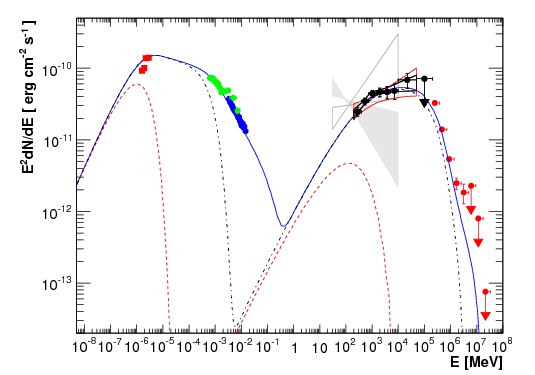Fermi Space Telescope Explores New Energy Extremes
[10.01.2012]

After more than three years in space, NASA's Fermi Gamma-ray Space Telescope is extending its view of the high-energy sky into a largely unexplored electromagnetic range. Today, the Fermi team announced its first census of energy sources in this new realm.
Fermi Detects 'Shocking' Surprise from Supernova's Little Cousin
[08.12.2010]

Astronomers using NASA's Fermi Gamma-ray Space Telescope have
detected gamma-rays from a nova for the first time, a finding that
stunned observers and theorists alike. The discovery overturns the
notion that novae explosions lack the power to emit such high-energy
radiation.
Fermi Gamma-ray Space Telescope and H.E.S.S. observe the blazar PKS 2155-304
[18.03.2009]

An international team of astrophysicists using telescopes on the ground and in space have
uncovered surprising changes in radiation emitted by an active galaxy. The picture that
emerges from these first-ever simultaneous observations in visible light, X-rays and gamma
rays is much more complex than scientists expected and challenges current theories of how the
radiation is
generated.
Read More!
Lire ici
GLAST launched!
[11.06.2008]

Stay updated on what is going on with GLAST by reading this GLAST blog !
Launch now set for 11 June 2008
[05.06.2008]
Don't forget to
check NASA's
Shuttle and Rocket Missions for upcoming missions.
With GLAST launched there are
opportunities for students to work with us in the field of
high-energy/particle astrophysical processes, data analysis or
computer
science. Again, contact
us for more information.
GLAST at the LLR
[04.11.2006]
Welcome to homepage of the GLAST LLR/IN2P3/CNRS group. The GLAST
project (Gamma-ray Large Area Space Telescope) is an astrophysics
and astro-particle physics partnership exploring the high energy
gamma-ray universe. This mission is a part of the NASA Office of
Space and Science Strategic Plan, with launch planned in 2008.
The satellite has a main instrument (the Large Area Telescope, LAT)
based on silicon strip detectors and a CsI Calorimeter, designed for
making observations of cosmic gamma-ray sources with energy between
about 30 MeV to 200 GeV. The French collaboration is contributing in
the LAT calorimeter subsystem and funded by IN2P3/CNRS. The LLR has
participated in the design and development of a hodoscopic CsI
calorimeter for GLAST.
The GLAST project is
funded in the US by NASA and the Department of Energy, and by
government agencies in France, Italy, Japan, and Sweden. The GLAST
project follows in the footsteps of the CGRO-EGRET mission.



